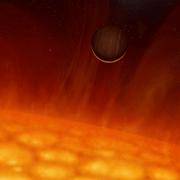 At least one planet seems to have survived being engulfed by its star.NPG
At least one planet seems to have survived being engulfed by its star.NPGPlanets circling close to their star — such as Earth around the Sun — aren't necessarily doomed to being swallowed up by that star, according to a new observation.
Stars such as our own expand into 'red giants' in their old age, engulfing nearby planets. Now a planet has been sighted circling close to V 391 Pegasi, a star that has gone through the red-giant phase to become what is known as a hot B-type subdwarf. The planet, it seems, survived this process.
Stars similar to our own Sun eventually burn up all the hydrogen in their core, causing the star to contract. After this, the outer layers of hydrogen fall into the hot helium core and start to fuse, making the core hotter than before. This is followed by a huge expansion of the hot star — the radius grows by up to 100 times. Anything caught in this expansion would be engulfed by the star and vaporized, all its material blended in with the star's.
This is the fate that some theorists predict Earth will meet in 5 billion or so years.
But the planet found by Roberto Silvotti at the National Institute for Astrophysics in Naples, Italy, turns this gloomy prediction on its head.
Star bright
Silvotti studied an unusual star, which helped his team to spot the planet. V 391 Pegasi, which has a very thin outer layer of hydrogen and a helium core that fuses to form carbon, pulsates regularly (every few minutes). Any change in gravitational pull around the star, caused for example by a circling planet, can easily be spotted as a change in these otherwise regular pulses.
ADVERTISEMENT
The planet that Silvotti found by using this technique, V 391 Peg b, is 1.7 astronomical units away from V 391 Pegasi. This is just within the 2 astronomical units thought to be too close for comfort for planets near red giants (one astronomical unit is the distance from Earth to the Sun). The planet orbits the star roughly once every 3.2 years and is also one of the oldest planets known, Silvetti says in his paper published today in Nature1.
Its discovery is exciting, says Matt Burleigh, an astronomer from the University of Leicester, UK. "This is the first time a planet has been found around a star that has evolved so far," he says. Burleigh is looking for planets around white dwarfs — stars further on still in their evolution than red giants, and Silvotti's research gives Burleigh hope that he will be successful. "This work suggests that planets should be there around white dwarfs," he says.
Final destiny
The destiny of Earth is still a matter for debate. Silvotti predicts that when the Sun becomes a red giant, Earth's orbit will be about one-and-a-half times its present radius, comparable to the distance of V 391 Peg b from its star. But the two situations aren't directly comperable. The mass of the planets are very different from each other, for example. And the expansion of the stars will be different too. Our Sun is expected to go through the red giant stage to a white dwarf rather than a hot subdwarf, for example.
All these differences mean our home's existence is still under threat, says Burleigh. "We lie right on the borderline between survival and being engulfed by the Sun's expanding atmosphere when it becomes a giant," he estimates. And after the Sun becomes a hot white dwarf the Earth will be bombarded by intense X-ray and UV radiation — enough to sterilise the Earth's surface, says Burleigh. "If our planet survives, it will probably be a barren rock, unfortunately."
Visit our survivesstellar_explos.html">newsblog to read and post comments about this story.
